new posts in all blogs
Viewing: Blog Posts Tagged with: recap post, Most Recent at Top [Help]
Results 1 - 6 of 6
How to use this Page
You are viewing the most recent posts tagged with the words: recap post in the JacketFlap blog reader. What is a tag? Think of a tag as a keyword or category label. Tags can both help you find posts on JacketFlap.com as well as provide an easy way for you to "remember" and classify posts for later recall. Try adding a tag yourself by clicking "Add a tag" below a post's header. Scroll down through the list of Recent Posts in the left column and click on a post title that sounds interesting. You can view all posts from a specific blog by clicking the Blog name in the right column, or you can click a 'More Posts from this Blog' link in any individual post.

By:
Jalissa Corrie,
on 9/1/2016
Blog:
The Open Book
(
Login to Add to MyJacketFlap)
JacketFlap tags:
multicultural books,
Educators,
close reading,
Educator Resources,
Dear Readers,
Latino/Hispanic/Mexican,
guided reading,
Lee & Low Likes,
ELL/ESL and Bilingual Books,
Book Lists by Topic,
Holidays and Celebrations,
recap post,
children's books,
Uncategorized,
literacy,
Diversity,
Add a tag

By:
keilinh,
on 7/26/2016
Blog:
The Open Book
(
Login to Add to MyJacketFlap)
JacketFlap tags:
children's books,
Diversity,
Summer,
book fairs,
intern,
harlem book fair,
Musings & Ponderings,
Lee & Low Likes,
we need diverse books,
recap post,
wndb internship,
summer intern,
Add a tag
 Pia Ceres is LEE & LOW’s summer intern. She is a recipient of the We Need Diverse Books Internship Program grant. She’s a rising senior at Brown University, where she studies Education & Comparative Literature, with a focus in French literature. When she’s not reading, you can find her watching classic horror movies from under a blanket, strumming pop songs on her ukulele, and listening to her grandparents’ stories about the Philippines. In this blog post, she talks about her first book fair with LEE & LOW BOOKS.
Pia Ceres is LEE & LOW’s summer intern. She is a recipient of the We Need Diverse Books Internship Program grant. She’s a rising senior at Brown University, where she studies Education & Comparative Literature, with a focus in French literature. When she’s not reading, you can find her watching classic horror movies from under a blanket, strumming pop songs on her ukulele, and listening to her grandparents’ stories about the Philippines. In this blog post, she talks about her first book fair with LEE & LOW BOOKS.
By morning, a sticky summer swelter had set in, but the anticipation was unmistakable, electric in the air. They would be coming soon. Across two blocks, along 135th Street and Malcolm X Boulevard, booksellers, authors, and representatives from nonprofits fussed with tents and paraphernalia. Somewhere I couldn’t see, a live jazz band began to practice; its strident trumpet blared the beginning of a celebration. In moments, the hot asphalt would be teeming with families and lovers of literature from around the country gathering for the Harlem Book Fair.
The Harlem Book Fair is the largest African-American book fair in the country. With the aim of celebrating literacy within the Black community, the fair, held annually, offers a full day of presentations and rows of exhibition booths. Although it kicked off its 18th successful year last Saturday, this was my very first time participating in a book fair. Helping Keilin and Jalissa represent LEE & LOW and sell some of our books, I was open to every possibility.
The challenge came early on: Someone asked me to find a book for her niece, then added, “She hates reading.” Yikes. Sounds like a tall order, but not surprising. Most of the educators and families who stopped by our booth were concerned that their kids didn’t see themselves in the books assigned at school. It reminded me of when I was a kid and had to read about primarily white boys and the wilderness or dogs or something. For this woman, I suggested The Hula-Hoopin’ Queen. Maybe, I hoped, this would be the book that would start to change things.
At a book fair, one sees firsthand that books, particularly children’s books, are a meaningful part of relationships – an aunt wishing her niece a story that reflects her. I spoke with a dad who wanted an exciting bedtime story; a soon-to-be teacher, eager to fill her first classroom with books as diverse as her students; a mom who wanted to share her native language, and her young daughter who wanted to read it. As I listened to people’s requests, the book fair revealed a striking truth: For a lot of folks, books are expressions of love.
Of course, the day ended with a sudden and cinematic downpour, with jabs of wind that caused our white tent to take to the air like a storm-battered sail and had Keilin, Jalissa, and I drenched, scrambling to protect the books! Because if any day reminded us that books are precious, it was this one.
If books bridge worlds, then book fairs are a space for bridging those connections. The Harlem Book Fair allows diverse stories to come into people’s hands and helps create a world-full of readers – reflected, interconnected, loving and loved.

By:
rgarcia406,
on 2/3/2015
Blog:
The Open Book
(
Login to Add to MyJacketFlap)
JacketFlap tags:
Awards,
ALA,
children's books,
Book News,
Uncategorized,
Diversity,
Pat Mora,
Coretta Scott King Award,
Race,
multicultural books,
African/African American Interest,
Dear Readers,
Latino/Hispanic/Mexican,
Lee & Low Likes,
Diversity, Race, and Representation,
Diversity 102,
recap post,
Little Melba,
Little Melba and her Big Trombone,
Arbuthnot Honor,
Día,
Water Rises,
Water Rolls,
Add a tag
Yesterday was the ALA Youth Media Awards, or the “Oscars of Children’s Literature” as they’re sometimes called. It was a big day for diversity. Diverse books and authors were honored across the board and we couldn’t be happier.
Little Melba and Her Big Trombone, written by Katheryn Russell-Brown and illustrated by Frank Morrison, received the Coretta Scott King Honor for Illustration. Little Melba follows the life of famed trombonist, composer, and arranger Melba Liston who broke through racial and gender barriers to become one of the great unsung heroes of jazz.
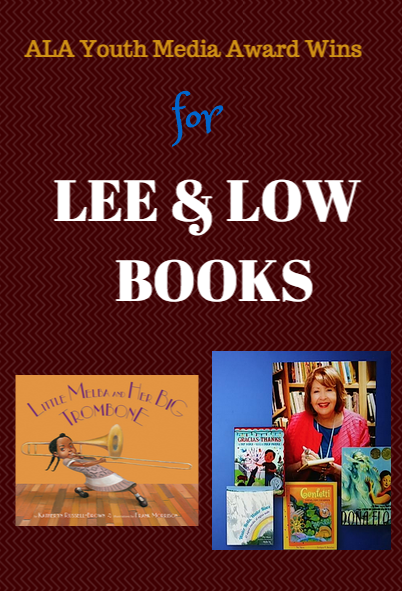
Pat Mora, author of Water Rolls, Water Rises/El agua rueda, el agua sube and many other award-winning titles, won the 2016 May Hill Arbuthnot Honor Lecture Award! This award recognizes an author, librarian, or children’s lecturer who will then present a lecture at a winning host site. In addition to her writing, Pat Mora is also a literacy
advocate. She created Día, a day that celebrates children and the importance of reading.
Congratulations to all the titles honored at the ALA Youth Media Awards!

By:
Jason Low,
on 10/22/2014
Blog:
The Open Book
(
Login to Add to MyJacketFlap)
JacketFlap tags:
diversity,
multicultural books,
Race issues,
Fairs/Conventions,
Diversity, Race, and Representation,
Activities and Events,
recap post,
Add a tag
On October 11, 2014, I attended a colloquium called Mind the Gaps, hosted by The Horn Book at Simmons College in Boston. There was an all-star line up consisting of Peter Brown (Mr. Tiger Goes Wild), Gene Luen Yang (Boxers and Saints), Andrew Smith (Grasshopper Jungle), and Steve Sheinkin (The Port Chicago 50), to name a few. Roger Sutton, Editor in Chief of The Horn Book, played a big part in pulling all these folks together for a day.
One of the highlights was the keynote by author/librarian Vaunda Micheaux Nelson (No Crystal Stair). Here’s a snippet from her speech:
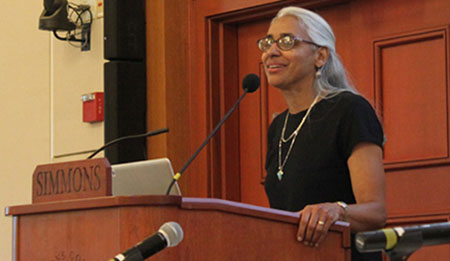
Keynote speaker, Vaunda Micheaux Nelson. Photo credit: Shara Hardeson
“We are here at Simmons trying to solve this problem while one of the biggest stories in the news is that Apple released a new iPhone. Yet ALA struggles to get a one-minute spot on one network to announce the nation’s most prestigious children’s book awards. Is this our world now? To quote one of my favorite library patrons, ‘Have we dumbed down society so much that what is truly significant is not considered important?’ This conversation is significant. So how do we make it important?”
I participated in was called Publishing for the Gaps. The other panelists were Arthur Levine, publisher of Arthur A. Levine Books at Scholastic but more famously known for bringing Harry Potter to the United States, and Ginee Seo, children’s book director of Chronicle Books. The moderator was Roger Sutton. We covered a lot of ground, from the acquisition process to responding to Roger’s charge that publishers often put out “derivative crap” (Roger’s words, not mine) when it comes to blatantly duplicating what works. This statement was met with Arthur’s vehement defense that he sorely doubted that publishing executives would order their editors to make “more derivative crap!”
While I have been on many panels over the years, what was nice about this one was that the audience of 150 was predominately white. Non-diverse audiences like this usually benefit from hearing about the diversity problem, since some may be hearing about it for the first time. Publishing for the Gaps for me is about publishing the stories about people who are left out, which are most often people of color. I discussed LEE & LOW’s efforts to offer clarity and perspective, to help define the scope of why diversity is met with obstacles across most media channels, and how this remains a society-wide problem.
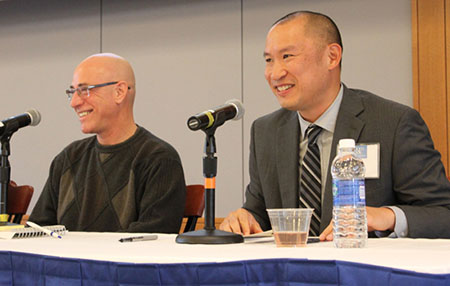
(L-R) Arthur Levine, Jason Low. Photo credit: Shara Hardeson
From the editorial side, the lack of representation can be greatly improved by decision makers who feel a personal stake in publishing diverse books. Ginee, as one of the few Asian American women at an executive level, can and does make a difference. Arthur Levine remarked that it was a part of who he is (as an openly gay and Jewish man) to publish inclusively.
The panel was recorded and is an hour. Note: Since the video is stored on Simmons College’s Google drive you’ll have to log in to view it. I also apologize in advance for the sound quality.
When the colloquium was over, I asked one of the moderators, Nina Lindsay, how she thought the day went. She said, “I was pleased with the colloquium, but feel like we just got the conversation started, then everyone went home. I’m hoping the momentum continues to build on this, and that we don’t all suddenly assume we’re enlightened and part ways.”
Recap of Publishers Weekly Diversity Panel, October 16, 2014
Filed under:
Activities and Events,
Diversity, Race, and Representation,
Fairs/Conventions,
recap post Tagged:
diversity,
multicultural books,
Race issues 


By:
Hannah,
on 10/17/2014
Blog:
The Open Book
(
Login to Add to MyJacketFlap)
JacketFlap tags:
cosplay,
NYCC,
Diversity in YA,
Fairs/Conventions,
Diversity, Race, and Representation,
Diversity 102,
recap post,
comics,
Comic Con,
Add a tag
 Stacy Whitman, Publisher of the Tu Books imprint of LEE & LOW BOOKS, gives us a recap of the 2014 New York Comic Con (NYCC) event and two big panels on diversity.
Stacy Whitman, Publisher of the Tu Books imprint of LEE & LOW BOOKS, gives us a recap of the 2014 New York Comic Con (NYCC) event and two big panels on diversity.
The #WeNeedDiverseBooks and #geeksofcolor hashtags were well represented at Comic Con this year, with three panels discussing diversity and several more panels where the subject came up. Publishers were showcasing their diverse titles among their frontlist promotions. And panels about diversity topics, even those held in large rooms at inconvenient times, were standing room only all weekend—a clear sign to me that this subject is on the minds of more and more people lately.
I missed the #WeNeedDiverse(Comic)Books panel, but you can see a recap of it here. Read on for recaps of the panels I attended:
Geeks of Color Go Pro panel
I arrived early, wanting to be able to get a good seat, and only two people were waiting in line—which made me nervous. Last year, the Geeks of Color panel was packed full. Would they repeat that this year the 8pm Thursday time slot, which admittedlywas less than ideal?
I needn’t have worried. Soon the room filled to capacity, perhaps 400-500 people, mostly people of color who were fans, interested in writing or illustrating themselves, or who had family members interested. Diana Pho, an editor at Tor, moderated the panel. Panelists were LeSean Thomas (BLACK DYNAMITE: THE ANIMATED SERIES; THE LEGEND OF KORRA; THE BOONDOCKS), Tracey J. John (MTV.com; Gameloft), Alice Meichi Li (Dark Horse), Daniel José Older (Author, HALF-RESSURECTION BLUES); and I. W. Gregorio (Author, #WeNeedDiverseBooks).
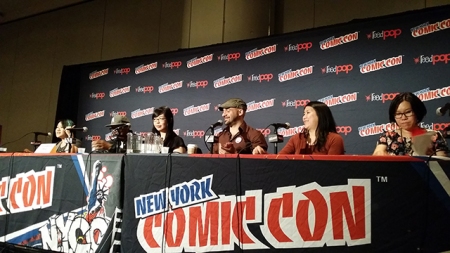
from L to R: Diana Pho, LeSean Thomas, Alice Meichi Li, Daniel José Older, I.W. Gregorio, and Tracey J. John
Most of the time was taken with each panelist sharing their story of how they went pro. Their answers for how they became an animator, a writer and editor, an illustrator, a video game writer, and a surgeon and writer were as diverse as the panelists themselves, showing how many paths there are to a professional creative career. For example, Boondocks and Legend of Korra animator LeSean Thomas grew up in the projects and never attended college, but instead got into comics because the materials to draw were pretty cheap, he said. He found opportunities when he showed his work to his boss at a sports store where he worked after high school, and learned as he worked his way up.
Daniel José Older, on the other hand, was a paramedic and antiracist organizer. Getting published took him six years. “The publishing industry will make you learn patience,” he said.
I.W. Gregorio wanted to become a writer but followed the path to becoming a doctor because that was what one did in her family. But one day, someone told her, “you’ll never become a writer,” and that, she said, ticked her off enough to want to prove them wrong. She also mentioned that her job as a surgeon makes her writing career possible and gives her stories to tell.
Others spoke of internships, art classes, balancing day jobs, getting master’s degrees, and community building.
Tracey John, when asked what she wished she knew when she began, said that she wished she had known to challege the status quo. Now, she’s more willing to ask tough questions, she said—such as “why does Princess Peach need saving?”
Older suggested that writers of color need to “reimagine what success means for each of us” and to build community “rather than think of it as networking.” For people who are getting started, he suggested to find people who are willing to ground you and challenge you.
Alice Meichi Li said that “you are an average of the five people you interact with most in your life,” so look for people who fit three categories: an older mentor, an equal, and someone you can mentor, because you learn a lot from teaching.
The big question of the night came from one of the last audience members to ask a question: Why are we still having this conversation? When will we not need a geeks of color panel at 8:00pm in the corner? Diana Pho replied that she thinks we’ll need such panels until we hit critical mass—not just at Comic Cons, but in all of pop culture, of people who believe diversity matters. We here at LEE & LOW agree with Older’s concluding remark: the more people speak up, the less circular the conversation will be, and we can push the conversation forward.
Women of Color in Comics panel
Friday was the Women of Color in Comics panel, which I was thrilled to see was an equally packed room. Moderated by Regine Sawyer of the Women in Comics Consortium, this panel also featured Alice Meichi Li (Dark Horse), Alitha Martinez (penciler and inker for Marvel), Jamila Rowser (Girl Gone Geek blog), Juliana ‘Jewels’ Smith (comics artist, (H)AFROCENTRIC), Barbara Brandon-Croft (cartoonist), Geisha Vi (cosplay model), and Vanessa Verduga (actor, writer, producer).

A packed audience for the Women of Color in Comics panel
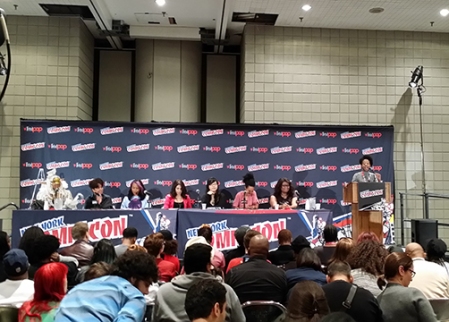
From L to R: Geisha Vi, Barbara Brandon-Croft, Jamila Rowser, Vanessa Verduga, Alice Meichi Li, Juliana ‘Jewels” Smith, Alitha Martinez, Regine Sawyer
The moderator, Regine, started out by asking what drew the panelists to comics and how they got started. Again, a diverse range of answers—from family influence to students introducing their teacher to comics, to a natural desire to draw as a child—led to a diverse range of paths into their professional work.
The panel also discussed the ongoing harassment issue in comics as well as genre and gaming. Young women are the fastest growing demographic, changing the base of the comics industry. The panelists were asked how they address feminine issues in their work. Alice Meichi Li (who was on the Geeks of Color panel), said that she loved how panels such as these were getting bigger. She addresses feminine mythology, the heroine’s journey, in her work, and argued that visibility made all the difference for readers. She told a story of reading Wizard magazine growing up, where the list of top ten writers in the back of the magazine were all white guys every time, except occasionally Jim Lee. To be able to see all kinds of people creating comics helps create demand from more diverse readers.
Jamila Rowser from the Girl Gone Geek blog said that from a fan perspective, the changing face of the industry shows the demand and the need for representation of women, particularly accurate representation of women of color. “When you don’t see people like you doing things you love, it’s discouraging,” she said.
The panelists also spoke of how sometimes they might feel invisible in the industry—Alitha Martinez, who has worked at major comic book houses as an artist, including work on a Batman comic, said that she’d been mistaken for cleaning staff before when arriving for a panel or other major professional event. Vanessa Verduga mentioned that sometimes she feels an expectation to whitewash herself, to fit within an expected personality structure rather than to be herself.
When asked why diversity was important in the first place, Jamila Rowser answered that a lack of diversity can stop readers’ enjoyment, but it can also discourage future creators, and stories set in the future with no diversity “erase our presence in the future.”
Alitha Martinez noted that women of color can’t remain on the fringes, shouting from the outside. She said that women tend not to approach editors at Marvel and DC, and that those are the places where change needs to happen most because they’re the biggest. In addition, Alice Meichi Li said that if we want to see change, as readers, we need to support that change with our wallets. “Ignoring creations by women and people of color is ignoring community,” she said. “Find your audience, know your community, know how to speak to them, and create your own niche.”
Throughout the weekend, I saw a widely diverse audience excited about comic books, animation, science fiction, fantasy, and games. Cosplayers were in abundance, including people of color. Here are a couple of my favorites:


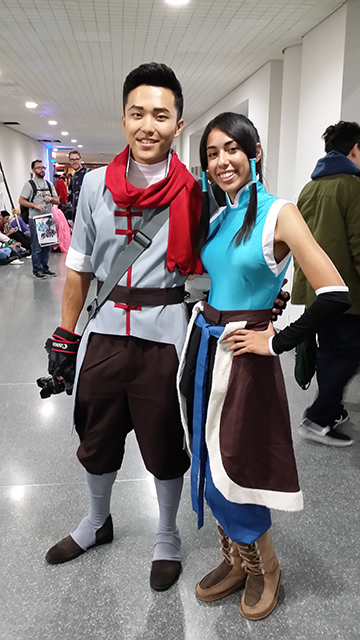
NYCC is a great example of why #WeNeedDiverseBooks, like those we publish!
Filed under:
Diversity 102,
Diversity in YA,
Diversity, Race, and Representation,
Fairs/Conventions,
recap post Tagged:
Comic Con,
comics,
cosplay,
NYCC 


By:
rgarcia406,
on 10/2/2014
Blog:
The Open Book
(
Login to Add to MyJacketFlap)
JacketFlap tags:
TV,
Nickelodeon,
Avatar: the Last Airbender,
legend of korra,
Bryan Konietzko,
LOK,
Korra,
Michael DiMartino,
recap post,
Add a tag

The Legend of Korra’s fourth and final season, Book 4: Balance, returns this Friday! You’ll be able to watch here. Trying to catch up with all three seasons in one day is a pretty tall order, but luckily the weekend will soon be here! The first three books (as seasons are called Avatar: The Last Airbender and Legend of Korra) are available streaming on Nick.com.
Avatar: the Last Airbender follows Aang, the last airbender, who survived the Air Nomad genocide from the Fire Nation. Together with his friends Sokka, Katara and Zuko, Aang fights to prevent the Fire Nation from taking over the whole world, all the while mastering all four elements.
The Legend of Korra is the direct sequel to Avatar: the Last Airbender, taking place 80 years after the end of ALTA. Korra, upon discovering she was the avatar at the age of four, was placed under the direct care of the Order of the White Lotus and learned to water-, fire-, and earthbending. Korra sneaks away from the Order of the White Lotus compound to learn airbending from Tenzin, the son of Avatar Aang, in Republic City.
Important Terms
Elements: Air, Water, Earth, and Fire.
Bending: The ability to control one of the aforementioned elements, i.e. waterbending. A person who bends an element is known as a bender.
Avatar: one person who has the ability to control all four elements. The avatar is born into one of the four nations and learns to bend the four elements. The Avatar is supposed to help maintain balance between the Four Nations and the spirits.

The Four Nations
Four Nations: Air Nomads, Fire Nation, Earth Kingdom, Water Tribe.
Team Avatar: the team of people who help and fight alongside the Avatar.
Pro-bending: a sport where benders fight each other with the elements. There are three benders per team: water, fire, and earth.
Order of the White Lotus: a formerly secret order that transcended the Four Nations to share philosophy and wisdom. Later, on the orders of Avatar Aang, they search and protect the next Avatar.
Red Lotus: a group that splintered off from the original White Lotus because they thought that the Order of the White lotus had become the bodyguards of the Avatar. They sought to free the world of its governments and have humans and spirits coexist. During Book 3, Zaheer leads them.
The Major Players
Team Avatar:
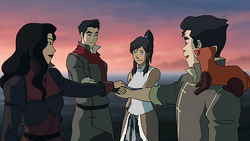
Team Avatar: Asami, Mako, Korra, Bolin and Pabu (from left to right).
Korra: Korra is from the Northern Water Tribe. She is born when Avatar Aang, the protagonist of Avatar: The Last Airbender died. Korra can bend all four elements.
Asami Sato: The only nonbender on Team Avatar. Asami is the owner of Future Industries, a company that makes cars known as the Sato-mobile and other technology.
Mako: former street rat turned cop. Former captain of the pro-bending team the Future Industry Fire Ferrets. Mako is a firebender and both Korra and Asami’s ex-boyfriend. He is Bolin’s older brother.
Bolin: formerly an actor and pro-bender, he is the funny-man of Team Avatar. He is an earthbender and has the special ability to lavabend. He is Mako’s younger brother.
Other important characters
Katara: Aang’s wife, waterbending master and Korra’s teacher.
Tenzin, Bumi, and Kya: Aang’s children. Tenzin is an airbender, and Korra’s airbending instructor. Kya is a waterbender. Bumi is a retired Fire Nation general who later gains the ability to airbend after Harmonic Convergence. You may refer to them as the “cloudbabies.”
Pema: Tenzin’s wife, a nonbender.
Jinora, Ikki, Meelo, and Rohan: Pema and Tenzin’s children. All airbenders. You may refer to them as the “airbabies.” Jinora is the first airbending master in a generation.
Lin Beifong: Chief of Republic City Police, metalbender. Toph Beifong’s daughter.
Book 1: Air
Korra has a difficult time learning how to airbend, because she’s unable to tap into the spiritual side of bending. She joins a pro-bending team known as the Fire Ferrets. An anti-bending movement known as the Equalist Movement gains in popularity. The leader, Amon, wants to get rid of bending and benders. Korra tries to balance learning to airbend, practice with the Fire Ferrets and defeating Amon. Korra finally learns to airbend, when Amon seals off all of her other bending abilities.
Book 2: Spirits
Six months after the end of Book 1, Republic City has a president who is supposed to represent the interests of benders and non-benders alike. When a spirit attacks at a festival that Korra attends, she decides to focus on learning spirit-bending instead of airbending, and her uncle Unalaq becomes her teacher. Unalaq tricks Korra into opening the spirit portals. Unalaq wants to join with a dark spirit to become the Dark Avatar and destroy the Avatar cycle. Korra learns of Won, the first Avatar. With the help of Jinora, Korra defeats Unalaq. Spirits and humans were never meant to live apart, so Korra doesn’t close the Spirit Portals. The world enters a new age where spirits and humans live together.
Book 3: Change
The spirits are disrupting life in Republic City, but Korra can’t get them to live peacefully with humans. When reports of people suddenly gaining the ability to airbend reach Korra, she travels with Tenzin, his family, and team Avatar to restore the Air Nomads. The Red Lotus, a criminal organization that tried to kidnap Korra when she was young, escapes from prison. The Red Lotus’s leader, Zaheer, is one of the new airbenders. Zaheer and his cronies go on a quest to rid the world of its leaders and the Avatar. Zaheer kills the Earth Queen and Ba Sing Se descends into chaos.
When Zaheer threatens all the new airbenders to get to Korra, Korra risks her life to save them.
Several weeks later, we see Korra in a wheelchair getting ready to attend Jinora’s airbending master ceremony. Jinora, Avatar Aang’s granddaughter becomes the first airbending master in a generation. Tenzin announces that the airbenders will regain their nomadic roots
Korra returns with her parents to the Northern Water Tribe to heal.
Legend of Korra returns THIS FRIDAY.
The trailer: with Korra kicking major butt and new hair!
Watch the opening clip.
This is a clip of Kai and Opal airbending some bad guys!
I hope you’re just as excited to return to Republic City as I am!
Filed under:
recap post,
TV Tagged:
Avatar: the Last Airbender,
Bryan Konietzko,
Korra,
legend of korra,
LOK,
Michael DiMartino,
Nickelodeon 

 International Literacy Day-September 8
International Literacy Day-September 8
















Lee & Low is welcome to take a look at my three complete contemporary commercial Diversity YA novels set in China, Germany, Mexico & the US with some LGBT in two of them. You might connect especially with My Chinese YA fiction set mostly in China and promoting friendship between China and the US. Everyone talk about #WeNeedDiversityBooks but very few offer practical solutions to address the problem. Just my point of view.